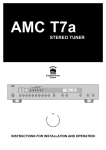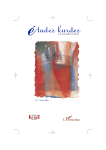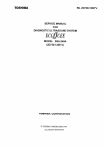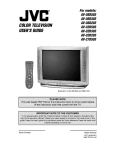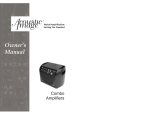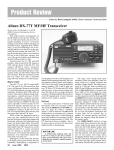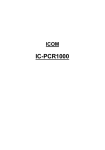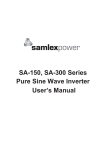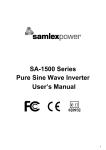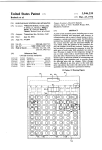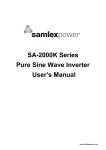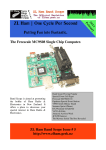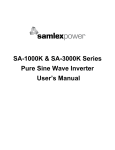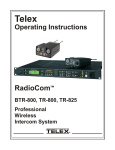Download ICR-75A QST revisi..
Transcript
Product Review & Short Takes Columns from QST Magazine January 2000 Product Reviews ICOM IC-R75 Communications Receiver QST Compares: Switching Power Supplies Short Takes Palomar Engineers VLF Converter RadioCom 4.0 Copyright © 2000 by the American Radio Relay League Inc. All rights reserved. PRODUCT REVIEW ICOM IC-R75 Communications Receiver By Rick Lindquist, N1RL Senior News Editor If you’ve ever thought it might be great to have an extra set of ears in the shack, you’d be wise to consider this latest “communications receiver” from ICOM. Let’s face it: Hams, as a rule, do not find much use these days for standalone receivers. Most of the boxes we buy also contain the requisite transmitting circuitry; being able to fit that capability into the IC-R75 box (an IC-TR-75?) would make an especially attractive package. But even as a “mere” receiver the IC-R75 is a terrific complement for the typical ham shack. A Receiver in the Shack? A dwindling number of us still remember the days when a discrete receiver was standard equipment in every ham shack. Today, that’s the exception, of course. Most hams will claim they have no use for a separate receiver—they’ve got a general-coverage receiver in their transceiver box. Maybe so, but few “transceiver” receivers are designed for the primary function of listening—something a few of us enjoy doing when the blush is off the latest contest or DXpedition feeding frenzy. For the SWL or BCL, of course, listening is the only game. The IC-R75 is definitely designed for listening—which is, of course, as it should be. An all-mode receiver, it also offers things like synchronous AM detection to enhance AM broadcast enjoyment by ameliorating the effects of multipathing and fading. It also incorporates superb dual passband tuning to combat interfering signals, plus the possibility to add optional crystal filters for enhanced selectivity. Simply push the FIL button to set the narrow filter for the mode you’ve selected (if installed). You’ll find CW, CW-R (reverse) and RTTY mode settings. Another nice touch: it offers adjustable CW pitch, via the menu. This triple conversion design has IFs at 69 MHz, 9 MHz and 455 kHz. While it only draws about 1 A at full volume, the AF stage delivers a healthy 2 W or so to the frontfiring speaker. The LF capabilities of this receiver are something to keep in mind in terms of the pending request by the ARRL to allocate bands at 136 kHz and at 160-190 kHz. Experimenters and QRP enthusiasts who enjoy building transmitters might find an able companion for their endeavors in the R75. But from my point of view, the coolest feature of the IC-R75 is its ability to truly integrate itself into a ham shack. Own an IC-706 or one of the other later-model ICOM transceivers with a computer REMOTE jack? With a simple connecting cable you can make up yourself, the IC-R75 becomes a main or auxiliary receiver—each unit controlling the other and letting you share the best features of each. Hook it up to your ’706 and you can share the IC-R75’s ability to punch in frequencies on the keypad or even the receiver’s stored memories. For ham radio use, you’ll need to add a T/R switching system. It’s a great opportunity to resurrect that old Dow-Key relay you’ve got in the junk box from your “separate-receiver” Novice days. An Accessible Receiver The IC-R75 suggests a cross between the IC-706 and IC-746 transceivers—a bit closer to the latter in terms of size, styling, and front-panel layout, but more compact and without the large LCD screen. The R75’s sizeable display offers big numbers (or channel names—it’s your call) and yellow-orange backlighting. There’s a multisegment LED S meter that reads out up to Bottom Line A versatile HF/6-meter receiver that offers a good measure of performance in a compact package. All mode capability for the ham and utility listeners and synchronous AM for the SWLs should make the IC-R75 a popular choice for a wide variety of radio enthusiasts. Joe Bottiglieri, AA1GW 60 dB over S9. Numerals almost as large as the frequency display tell you which memory you’ve got dialed up. Other important icons are clear and prominent. Like the “original” IC-706, there’s no band switch. You can directly enter a new frequency or set the tuning step to the correct display digit and dial away. Up and down buttons let you page swiftly through memories—all 99 of them. The front-panel layout is sensible and accessible. This is a piece of gear you literally can get your hands on without your fingers getting in the way of what you’re trying to do. There’s a nice large knob with a decently sized dimple on it. The knob incorporates a rubber grip ring. It has a nice “feel” to it. The drag is adjustable. You can lock the settings with a push of the LOCK button on the front panel. A metal bail is easily deployed from the bottom of the set to angle up the front panel for better viewing. The right-hand frequency keypad (which also functions to enter memory channel names) is terrific. All buttons and knobs are substantial and clearly labeled. There’s a 1 /4 -inch phone jack on the front panel. Much of being able to operate this little receiver I learned from my experiences with other ICOM gear. You can connect two separate antennas to the IC-R75 and select either from a front panel button. I’d have preferred to see two 50-Ω SO-239 connectors, but the IC-R75 offers an SO-239 for ANT 1 and snap-on connectors for ANT 2 to wire a 500-Ω (or other high impedance) antenna, such as a longwire. The receiver powers from 13.8 V dc via Assistant Technical Editor From January 2000 QST © ARRL Table 1 ICOM IC-R75, serial number 01206 Manufacturer’s Claimed Specifications Frequency coverage: 0.03-60 MHz. Power requirement: 1.1 A, 11.7-15.9 V dc. (An ac power supply is provided) Modes of operation: SSB, CW, AM, S-AM, FM, AFSK. Receiver SSB/CW sensitivity, bandwidth not specified, 10 dB S/N: 0.1-1.8 MHz, <2.0 µV; 1.8-28 MHz, <0.16 mV; 28-30 MHz, <0.18 mV; 50-54 MHz, <0.13 µV. AM sensitivity, 10 dB S/N: 0.1-1.8 MHz, <5.6 µV; 1.8-30 MHz, <1.6 mV; 50-54 MHz, <1 µV. FM sensitivity, 12 dB SINAD: 28-30 MHz, <0.22 µV; 50-54 MHz, <1 µV. Blocking dynamic range: Not specified. Two-tone, third-order IMD dynamic range: Not specified. Third-order intercept: Not specified. Second-order intercept: Not specified. FM adjacent channel rejection: Not specified. FM two-tone, third-order IMD dynamic range: Not specified. S-meter sensitivity: Not specified. Squelch sensitivity: SSB, CW, RTTY, <5.6 µV; FM, <0.32 µV. Receiver audio output: 2 W at 10% THD into 8 Ω. IF/audio response: Not specified. Spurious and image rejection (except IF rejection on 50 MHz): 70 dB. Size (hwd): 3.7×9.5×9 inches; weight, 6.6 pounds. Measured in the ARRL Lab As specified 1. 2 A. Tested at 13.8 V. As specified. Receiver Dynamic Testing Noise floor (mds), 500 Hz filter: Preamp off Preamp one Preamp two 1.0 MHz –130 dBm –137 dBm –140 dBm 3.5 MHz –133 dBm –141 dBm –143 dBm 14 MHz –132 dBm –138 dBm –142 dBm 50 MHz –127 dBm –136 dBm –140 dBm 10 dB (S+N)/N, 1-kHz tone, 30% modulation: Preamp off Preamp one Preamp two 1.0 MHz 1.7 µV 0.8 µV 0.6 µV 3.8 MHz 1.2 µV 0.6 µV 0.4 µV 53 MHz 2.4 µV 1.0 µV 0.5 µV For 12 dB SINAD: Preamp off Preamp one Preamp two 29 MHz 0.5 µV 0.2 µV 0.2 µV 52 MHz 1.0 µV 0.4 µV 0.2 µV Blocking dynamic range, 500 Hz filter: Preamp off Preamp one Preamp two 3.5 MHz 122 dB 120 dB 115 dB 14 MHz 122 dB 120 dB 113 dB 50 MHz 119 dB* 119 dB* 111 dB* Two-tone, third-order IMD dynamic range, 500 Hz filter: Preamp off Preamp one Preamp two 3.5 MHz 91 dB 89 dB 87 dB 14 MHz 88 dB* 86 dB 87 dB 50 MHz 88 dB* 86 dB* 84 dB* Preamp off Preamp one Preamp two 3.5 MHz +3.6 dBm –7.7 dBm –13 dBm 14 MHz –0.3 dBm –9.1 dBm –17 dBm 50 MHz +4.9 dBm –7.1 dBm –14 dBm Preamp off, +60 dBm; preamp one, +65 dBm; preamp two, +51 dBm. 20 kHz channel spacing, both preamps on: 29 MHz, 67 dB; 52 MHz, 60 dB. 20 kHz channel spacing, both preamps on: 29 MHz, 67 dB*; 52 MHz, 70 dB*; 10 MHz channel spacing, both preamps on, 52 MHz, 106 dB. S9 signal at 14.2 MHz: preamp off, 82 µV; preamp one, 31 µV; preamp two, 9.5 µV; 50 MHz, preamp off, 178 µV; preamp one, 60 µV; preamp two, 20 µV. At threshold, both preamps on: SSB, 16 µV; FM, 29 MHz, 0.08 µV; 52 MHz, 0.2 µV. 2.3 W at 10% THD into 8 Ω. Range at –6dB points, (bandwidth): CW-N (500 Hz filter): 221-972 Hz (751 Hz); CW-W: 67-2625 Hz (2558 Hz); USB-W: 87-2591 Hz (2504 Hz); LSB-W: 64-2597 Hz (2533 Hz); AM: 66-2510 Hz (2444 Hz). First IF rejection, 14 MHz, 81 dB; image rejection, 14 MHz, 72 dB. Note: Unless otherwise noted, all dynamic range measurements are taken at the ARRL Lab standard spacing of 20 kHz. *Measurement was noise-limited at the value indicated. 1Sensitivity reduced below 0.06 MHz. the supplied—and sizeable—ac adapter. Fortunately, it’s wired with a plug on the end of a cord so you don’t have to figure out where to plug in the hefty cube. A Capable Receiver The R75 packs a lot of performance into its compact frame. Keep in mind that ICOM was able to concentrate on simply producing a decent-performing receiver here; they From January 2000 QST © ARRL didn’t have to worry about what was happening on the transmitter side. With the R75, you’ve got a receiver that not only covers a huge chunk of the known HF spectrum plus the low end of the VHF (the only thing that would have made it better would be to have included coverage comparable to the IC-706, but that’s for the next version), but also has ample sensitivity over its coverage range. ARRL Lab test- ing showed the preamp-off sensitivity hovered around –130 dBm—right up there with the big boys—but it includes two preamp stages to boost sensitivity by as much as 10 dB. These really can come in handy! A few words on dynamic range: This is an aspect of receivers that, while important, often gets less than a full discussion in the typical transceiver review. It’s also something that many amateurs are still unfamil- iar with—at least as it pertains to receiver performance. In fact, outstanding receiver performance largely hinges on outstanding dynamic range, which defines a receiver’s ability to distinguish weaker signals in the presence of nearby, stronger ones. In the ARRL Lab, we measure dynamic range for SSB and CW in the CW mode with the narrowest filter employed and injecting “interfering” signals 20 kHz away from the signal we’re trying to listen to. The R75 is no slacker in this regard. The twotone third-order IMD dynamic range of the R75 is more than merely respectable—in the vicinity of 90 dB on HF through 50 MHz. This is in a league with the receivers in many mid-priced transceivers. As it does even on more expensive receivers, the two-tone third-order IMD degrades slightly with the application of the preamplifier. In this case, it’s no big deal— only a couple of dB or so (see Table 1). The presence of the preamps is a big boost— pun intended. A lot of people look at the third-order intercept number as a “measure of quality” for a receiver. This is an indication of how the receiver handles strong signals overall. While not outstanding in this regard, the receiver is in the “plus” numbers on 3.5 and 50 MHz, and it breaks even on 14 MHz. This is good. In very practical terms, this means that you can take this receiver out on a busy HF band during a contest weekend and—under optimal selectivity conditions—the front end won’t fold up when the neighborhood bully is bellowing down the band with his “killerwatt.” For “problem” situations, though, the R75’s twin passband tuning can be a huge plus. The radio also has an attenuator that comes in handy when too much gain becomes an issue. There’s plenty of sensitivity to go around in most cases. Up until now, we’ve been talking about CW and SSB performance by and large. Of course, with a receiver like this you’ll want to know how it does on AM and FM. Again, the sensitivity numbers are respectable or better—especially with the preamp engaged. I happen to enjoy listening to AM broadcasts, so this is a big plus. In fact, while checking out the R75, the local Public Radio station was “begging,” so the incentive was even greater to listen elsewhere. An even bigger plus is the inclusion of synchronous AM detection on the R75. On certain signals it can make all the difference between enjoyable and annoying listening. Simply push and hold the AM button once you’ve tuned in your station—it will switch to AM-S—and you’re in business. Less impressive was the two-tone thirdorder dynamic range on FM. It was in the 60 dB range, worst case, on HF and VHF (again, see Table 1). This number typically is comparable to FM adjacent channel rejection. Some VHF mobiles have better DR and adjacent channel numbers. This could impact the receiver’s ability to avoid interference from nearby signals. At wider spacings, the DR was much improved—106 dB at 50 MHz. Filters and DSP Digital signal processing is an option in this receiver, and it’s something I’d highly recommend (the IC-R75 accepts the same UT-106 DSP board as the later models of the IC-706). (ICOM is now including this as “standard equipment.”—Ed.) The DSP board adds audio-frequency level noise reduction and auto notch. It works in all modes, and it sure helps to make things easier on the ears when noise starts to get the best of the signals. The noise reduction level is adjustable via the menu. There’s also a noise blanker to minimize pulse-type noise. As with most upper-tier receivers, the IC-R75 lets you add a filter at the second and third IFs. The IC-R75 offers quite a few choices here. We added a 500-Hz CW filter at the higher IF, which is a real plus if you’re into CW. Real serious CW listeners will want a narrow CW filter at the lower IF too. ICOM offers CW filters at 250, 350 (CW/RTTY) and 500 Hz for the 9 MHz IF and 250 and 500 Hz at the 455-kHz IF. SSB filters are available at 1.9 and 2.8 kHz for the 9 MHz IF and 1.8, 2.8 and 3.3 kHz at the lower IF. A Versatile Receiver You can do a lot with the IC-R75, and within the performance limitations we’ve already outlined (and which are spelled out in detail in Table 1), the R75 provides lots of listening fun. Aside from its all-mode capabilities, the R75 gives you lots of scanning possibilities, and it’s easy to set up scanning. Programmed, memory, selective memory scans all are possible. There are two band-edge memories. A nifty inclusion is the auto memory write scan that automatically puts signals it encounters during a scan into a sequestered set of channels— 19 in all—for later review. There’s also a priority watch that will automatically keep an ear on a selected memory channel and go to it the instant it becomes active. I especially liked the ability to name memories, but I found the memory-naming method a bit out of the ordinary. To name a memory you input the character you want by pushing different keys on the keypad one or more times. For example, the [2] key inputs the numeral two and letters A, B and C, the [3] key the numeral 3 and the letters D, E, and F, and so forth. The appropriate letters are marked on the keys, just like a telephone keypad except the Q and Z are on the [0] key. The upside of this scheme is that it takes less time to input a name than systems that force you to scroll or step through all numbers and letters till you find the one you want. Memory names can be up to eight alphanumeric characters each. The IC-R75 lets you choose to display either the memory name or the frequency that it represents. Listeners often find they want to record some of the signals they hear. The IC-R75 accommodates recording by making line level audio available at a rear-panel jack. There’s also a REC REMOTE jack to turn your machine on and off. There’s a 24-hour clock built-in. For unattended listening, you can take advantage of the IC-R75’s timer and remote tape recorder hookups to automatically start your recorder either when the receiver hits a signal while scanning or at the appointed hour you’ve set on the timer. Computer Control Icing on the cake is the ability to control the IC-R75 via a genuine RS-232C connector on the rear panel to permit a serial connection to a PC. In addition, as already mentioned, the REMOTE jack on the rear panel allows connection with another similarly equipped ICOM receiver or transceiver or of up to four ICOM receivers to a PC for command control via an optional CT-17 CI-V level converter. The Instruction Manual provides details on commands. Computer control software, RS R75, has just become available. Menus The IC-R75 menu—accessible by simply pressing the front panel SET button— makes available a host of user-settable items ranging from the level of the “confirmation beep” that sounds when a button has been pressed to CW pitch, backlighting level, auto tuning speed, and front-panel display backlighting. The Last Word The IC-R75 stands ready to extend the listening capabilities of the average ham shack. If you enjoy listening to LF and HF, you’ll appreciate the IC-R75. Manufacturer: ICOM America, 2380 116th Ave NE, Bellevue, WA 98004, 425454-8155; fax: 425-454-1509; http://www. icomamerica.com. Manufacturer ’s suggested retail price: IC-R75, $949. Typical current street price, $800. FL-100 500 Hz CW/RTTY filter, $133; RS R75 software, $80. From January 2000 QST © ARRL QST Compares: Switching Power Supplies Reviewed by Joe Bottiglieri, AA1GW Do you occasionally enjoy taking your dc-powered transceiver along on your vacation or out into the field for generatorpowered operations—such as Field Day? Are you tired of hauling around that bulky transformer-based power supply? If this sounds familiar, you’ve probably noticed the wide selection of switching dc power supplies that have hit the Amateur Radio market over the last few years. Their compact size and light weight, fractions of that of the more conventional alternatives, would seem to make them the perfect traveling companion—particularly for use in conjunction with those subcompact multiband wonders that have become the radios of choice for squeezing into suitcases and backpacks. This time around we’ll have a look at the Astron SS-30M, the ICOM PS-85, the Kenwood PS-40, the MFJ-4225MV, the Samlex SEC 1223 and the Yaesu FP-1023. Each of these dc switching power supplies carries continuous output current ratings that make them suitable for use with any of the currently available 100 W transceivers. About the time that we were finalizing this review, Alinco announced the release of a switching supply of their own—the DM-330MV. ICOM has also redesigned and re-released an updated version of the PS-85. We’ll keep these two in mind as possible subjects for a future column. frequency ringing spikes while under load was also investigated. The resulting oscilloscope traces appear in the figures. A “dynamic test” was set up using an HF transceiver. In this test, each supply was subjected to a pulsed load that rapidly alternated between approximately 1.1 and 21 A. The resulting variation in the supplied dc voltage appears in the tables. In the final lab test, the supplies were set to 13.8 V (if adjustable) and a load that drew about 20 A was connected. The dc output of the supplies was ac-coupled to a spectrum analyzer and the analyzer was swept from 1.5 to 100 MHz. These spectral plots are also included as figures. Each of the supplies—of course—was also subjected to on-the-air testing in different locations and station configurations. More on those results later… Astron SS-30M The Astron SS-30M sports the largest cabinet in this group. Generously sized dual voltage and current meters take up nearly the entire front panel. A lighted rocker style power switch is located in the lower left hand corner. The Battery of Tests The lab tests run on each of the units began with measurements of the actual dc output voltage at loads of 1.1 A and 21 A. Next, a Variac was inserted in the ac line and the minimum ac voltage input required to retain proper regulation of the dc output was determined. (This value is recorded in the tables as the low line drop out voltage.) The amount of ripple on the dc output, and the presence—or absence—of any high From January 2000 QST © ARRL The dc connection points are located on the back panel and consist of two 1/4-20 threaded studs about 3 /4-inch long with hex nuts and washers. The polarity labeling for these can be difficult to see—the + and – symbols are Table 2 Astron SS-30M, serial number 98080024 Manufacturer’s specifications Power requirement: 90-132 V ac or 180-264 V ac at 50/60 Hz (switch selectable). Output voltage: 13.8 V dc. Output current (continuous): 25 A. Size (hwd): 3.75×7×8.63 inches; weight, 5 pounds. Lab Measurements Output voltage, no load: 13.83 V dc. Output voltage, 21 A load: 13.66 V dc. Low line drop out voltage: 94 V ac. Dc variation during dynamic testing: ≈150 mV. embossed into the metal and the terminals are not color-coded. You’ll want to pay close attention when hooking up your radios and accessories. The power cord is removable and— as is the case with most of these supplies—is the same type that’s typically used on computer equipment. A recessed switch allows selection of 110 or 220 V ac operation. A large temperature-controlled external cooling fan protrudes from the center of the rear panel. It only activates after extended operation under load. Once running, the sound level generated by the fan is low to moderate and the case temperature remains low even after 1/ 2 hour of continuous operation under a 21 A load. The documentation that’s packed with the SS-30M includes a sheet with a listing of the specifications of their entire line of switching supplies and a second sheet with information on their other power supply products. Manufacturer: Astron Corp, 9 Autry, Irvine CA 92618; 949-458-7277; fax 949458-0826; http://www.astroncorp.com. Manufacturer’s suggested price: $172. Typical current street price: $150. Manufacturer: ICOM America, 2380 116th Ave NE, Bellevue, WA 98004, 425454-8155; fax: 425-454-1509; http:// www.icomamerica.com. Manufacturer’s suggested retail price: $406. Typical current street price: $295. The Kenwood PS-40 Table 3 ICOM PS-85 serial number 01913 Table 4 Kenwood PS-40 serial number 80500885 The Kenwood PS-40 is approximately the same size as the TS-50 HF transceiver. A rocker type power switch is mounted on the front panel. A small red LED indicates when the supply is on. The power cord is removable. Large color-coded dc power terminals are mounted on the rear panel. The PS-40 is Figure 1—An oscilloscope trace of the dc output of the Astron SS-30M under load. The vertical scale is 50 mV/div, the horizontal scale is 5 ms/div. (Note: these scaling factors vary in some of the other figures.) The level of the dc ripple is very low, <20 mV p-p, and there are no discernable high frequency spikes. 0 Reference Level: 0 dB –10 –20 –30 –40 –50 –60 –70 –80 0 10 20 30 40 50 60 Frequency (MHz) 70 80 90 100 Figure 2—A spectral plot of the output of the Astron SS-30M under load. This supply exhibited very low levels of broadband noise, and the peaks that do appear fall outside of the US amateur bands above 160 meters. Manufacturer’s specifications Power requirement: 100-120 V ac (fixed). Output voltage 13.8 V dc ±5%. Output current (continuous): 20 A. Size (hwd): 3.7×4.4×11.3 inches; weight, 5.5 pounds. Lab Measurements Output voltage, no load: 13.9 V dc. Output voltage, 21 A load: 13.6 V dc. Low line drop out voltage: 80 V ac. Dc variation during dynamic testing: ≈200 mV. Manufacturer’s specifications Power requirement: 115/230 V ac ±10 % at 50/60 Hz (switch selectable). Output voltage: 13.8 V dc ±5 %. Output current: (continuous) 20 A. Size (hwd): 2.5×7×8.9 inches; weight, 4.4 pounds. Lab Measurements Output voltage, no load: 14.4 V dc. Output voltage, 21 A load: 14.14 V dc. Low line drop out voltage: 97 V ac. Dc variation during dynamic testing: ≈200 mV. Figure 3—An oscilloscope trace of the dc output of the ICOM IC-85 under load. The vertical scale is 100 mV/div and the horizontal scale is 5 ms/div. The level of the dc ripple is about 100 mV p-p, and there are spikes due to switching that extend out to about 600 mV p-p. Figure 5—An oscilloscope trace of the dc output of the Kenwood PS-40 under load. The vertical scale is 50 mV/div and the horizontal scale is 5 ms/div. The level of the dc ripple is low, <20 mV p-p, but there are spikes due to switching that extend out to about 200 mV p-p. ICOM PS-85 The ICOM PS-85 is designed to be the “matching supply” for a number of the HF and multiband transceivers in their line. The front panel is small—about 4 inches square— and the enclosure is rather deep. A rocker type power switch and a red LED power indicator are mounted on the front panel. The ac power cord is removable. The dc power cord is about 18 inches long and is permanently attached. It terminates in a sixpin Molex connector that mates with most of the current 100 W transceivers. Separate terminals for powering additional station accessories are not provided. The PS-85 is the only supply in this group that does not include the ability to convert it for 220 V ac operation. An internal cooling fan is mounted just inside the back panel. The fan is not temperature controlled—it runs continuously when the supply is on. The sound level of the fan is moderate. The case temperature remained low even after 1/ 2 hour of continuous operation into a 21 A load. ICOM includes a single Instructions sheet with operating instructions and specifications. 0 0 Reference Level: 0 dB Reference Level: 0 dB –10 –10 –20 –20 –30 –30 –40 –40 –50 –50 –60 –60 –70 –70 –80 0 –80 0 10 20 30 40 50 60 Frequency (MHz) 70 80 90 100 Figure 4—A spectral plot of the output of the ICOM PS-85 under load. This supply exhibited the highest levels of broadband noise of the group. 10 20 30 40 50 60 Frequency (MHz) 70 80 90 100 Figure 6—A spectral plot of the output of the Kenwood PS-40 under load. While there are some ranges where broadband noise is evident, the majority of these are outside of the US amateur bands. From January 2000 QST © ARRL the only supply in this group to include a separate connection point for chassis ground. A small recessed slide switch allows you to easily select between 110 and 220 V ac operation. The cooling fan is mounted externally on the rear panel. It runs continuously when the power is on. The sound level of the fan is moderate to high—the loudest of the bunch. The supply remains cool even after 1/ 2 hour of continuous operation with a 21 A load. Kenwood provides a 4-page Instruction Manual that includes sections on connection, operation, specifications and troubleshooting—including tips on reducing interference. Manufacturer: Kenwood Communications Corp, 2201 E Dominguez St, Long Beach, CA 90801; 310-639-5300, fax 310537-8235; http://www.kenwood.net. Manufacturer ’s suggested retail price: $230. Typical current street price: $225. rocker style power switch is mounted on the front panel. The power cord is removable. The dc connection points are large, color-coded 5way binding posts. The supply can be eas- Figure 7—An oscilloscope trace of the dc output of the MFJ-4225MV under load. The vertical scale is 50 mV/div and the horizontal scale is 5 ms/div. The level of the dc ripple is low, <20 mV p-p. Spikes due to switching only measure about 70 mV p-p. Table 6 Samlex SEC 1223 0 Reference Level: 0 dB –10 Manufacturer’s specifications Power requirements: 100-130 V ac or 200-260 V ac at 50/60 Hz (jumper selectable). Output voltage: 13.8 V dc. Output current (continuous): 23 A. Size (hwd): 2.2×7×8.25 inches; weight, 3.5 pounds. –20 –30 –40 MFJ-4225MV The MFJ-4225MV is shaped a bit like a cube—it’s taller, narrower and shallower than most of the other supplies in this roundup. The front panel is busy—there are large backlit meters for current and voltage, a rocker type power switch, LED indicators for the power and fan and a cigarette-lighter type dc power jack. Five way binding posts for the dc output are provided on the front panel. This supply is the only one in the group that offers an external control for the output voltage. The voltage is variable from Table 5 MFJ-4225MV Manufacturer’s specifications Power requirements: 85-135 V ac at 47-62 Hz or 170-260 V ac at 47-63 Hz (switch selectable). Output voltage (variable): 9-15 V dc. Output current (continuous): 22 A. Size (hwd): 4.5×5.75×6 inches; weight, 3.7 pounds. Lab Measurements Output voltage, no load: 14.4 V dc. Output voltage, 21 A load: 14.14 V dc. Low line drop out voltage: <85 V ac. Dc variation during dynamic testing: ≈200 mV. From January 2000 QST © ARRL –50 –60 –70 –80 0 10 20 30 40 50 60 Frequency (MHz) 70 80 90 100 Figure 8—A spectral plot of the output of the MFJ-4225MV under load. Overall, the noise generated by this supply is very low, with the exception of the range of frequencies between about 7.5 and 10 MHz. about 9 to 15 V dc—very handy for test bench applications. The ac power cord is permanently attached to the cabinet. The back panel includes a recessed slide switch for easy selection of 110 or 220 V ac operation. The cooling fan is mounted internally just inside the left panel of the cabinet. The fan is on continuously when power is supplied to the unit, but the fan speed (and the meter backlighting level) varies with the output voltage setting. The level of sound generated by the fan at the 13.8 V dc output setting is moderate. The power supply is cool to the touch even after 1/ 2 hour of continuous operation connected to a 21 A load. A 4-page Instruction Manual is provided and includes a table of specifications, installation and operating instructions and a detailed schematic. Manufacturer: MFJ Enterprises, 300 Industrial Park Rd, Starksville, MS 39759; 800-647-1800; fax 662-323-6551; http:// www.mfjenterprises.com. Manufacturer’s suggested retail price: $150. Typical current street price: $140. Samlex SEC 1223 The Samlex 1223 ties the Yaesu FP-1023 for “smallest enclosure” honors. A lighted Lab Measurements Output voltage, no load: 13.94 V dc. Output voltage, 21 A load: 13.79 V dc. Low line drop out voltage: 95 V ac. Dc variation during dynamic testing: ≈200 mV. Figure 9—An oscilloscope trace of the dc output of the Samlex 1223 under load. The vertical scale is 200 mV/div and the horizontal scale is 10 ms/div. The level of the dc ripple is low, <30 mV p-p, but there are spikes due to switching that extend out to about 600 mV p-p. 0 Reference Level: 0 dB –10 –20 –30 –40 –50 –60 –70 –80 0 10 20 30 40 50 60 Frequency (MHz) 70 80 90 100 Figure 10—A spectral plot of the output of the Samlex 1223 under load. There are several ranges—including several within the US amateur bands, where the broadband noise is moderate. ily converted for 220 V operation by removing an internal jumper. The cooling fan is temperature controlled. It’s mounted internally and forces air out through a grill on the bottom of the cabinet. Once activated, the sound level of the fan noise is moderate. The enclosure, particularly the front panel, warms up considerably after 1 /2 hour of continuous operation powering a 21 A load. A small 6-page User Manual, with installation and operating instructions, a specifications table, a troubleshooting guide and details on removing the jumper for 220 V ac operation, is included. Manufacturer: Samlex America, 110-17 Fawcett Rd, Port Coquitlam BC, Canada V3K 6V2; 800-561-5885; fax 604-5255221; http://www.samlexamerica.com. Manufacturer ’s suggested retail price: $100. Typical current street price, $100. Figure 11—An oscilloscope trace of the dc output of the Yaesu FP-1023 under load. The vertical scale is 200 mV/div and the horizontal scale is 10 ms/div. The level of the dc ripple is low, <30 mV p-p, but there are spikes due to switching that extend out to about 600 mV p-p. 0 Reference Level: 0 dB –10 –20 –30 The Yaesu FP-1023 –40 The Yaesu FP-1023 and the Samlex are very similar. The enclosure is small and seems well suited for portable operation where luggage space is at a premium. A lighted rocker style power switch is mounted on the front panel. The power cord is removable. The dc connection points are large, color-coded 5way binding posts. Conversion for 220 V ac operation is easy—simply remove an internal jumper. The cooling fan is temperature controlled. It’s mounted internally and forces air out through a grill on the bottom of the cabinet. Once activated, the sound level of the fan noise is moderate. The supply en- –50 Figure 12—A spectral plot of the output of the Yaesu FP-1023 under load. There are several ranges—including several within the US amateur bands, where the broadband noise is moderate. Table 7 Yaesu FP-1023 Operational Impressions and Considerations Manufacturer’s specifications Power requirements: 100-130 V ac or 200-260 V ac at 50/60 Hz (jumper selectable). Output voltage: 13.8 V dc. Output Current (continuous) 23 A. Size (hwd): 2.2×7×8.25 inches; weight, 3.5 pounds. A quick glance through this collection of oscilloscope traces and spectral plots indicates—at least as far as the overall purity of the supplied dc power is concerned— that the clear choices here are the Astron SS-30M or the MFJ-4225. These exhibit admirable performance and deserve praise for their superior design. Before you pull out your credit card and dial up your favorite Amateur Radio products dealer, however, let’s consider the actual implications of selecting one of the runners up. On-the-air tests helped to shed some Lab Measurements Output voltage, no load: 13.9 V dc. Output voltage, 21 A load: 13.75 V dc. Low line drop out voltage: 90 V ac. Dc variation during dynamic testing: ≈200 mV. –60 –70 –80 0 10 20 30 40 50 60 Frequency (MHz) 70 80 90 100 closure, especially the front panel, gets considerably warm after about 1 /2 hour of continuous operation connected to a 21 A load. A small 6-page User Manual, with installation and operating instructions, a specification table, a troubleshooting guide and details on removing the jumper for 220 V ac operation, is included. Manufacturer : Yaesu USA, 17210 Edwards Rd, Cerritos, CA 90703; 562-4042700, fax 562-404-1210 http://www.yaesu. com. Manufacturer’s suggested retail price: $169. Typical current street price, $149. light on a very important consideration: the level of the broadband RF noise that’s generated by these supplies is proportional to the load. The oscilloscope traces and the spectral plots represent the characteristics of the supplied dc power at loads that simulate transmit conditions. Since, under the majority of operating conditions, transmission and reception will not be occurring simultaneously, the levels of RF noise experienced during receive—when the load is typically only about 5% that of transmit—are considerably smaller. This was verified in the field testing. Each of the six power supplies was substituted for the existing conventional dc supplies in three typical HF station configurations. Five of the six supplies tested did not generate any perceivable interference in the station receivers—even when these were tuned to the frequencies outside of the ham bands where the spectral plots indicated elevated levels of RF noise. This is certainly good news for 160-meter operators and those who enjoy exploring the shortwave bands occasionally! “How does this one sound?”-type transmit quality testing using SSB, FM and CW also revealed no noticeable difference in the quality of the transmitted signals when powering the transceivers using either the conventional or the switching supplies. The only supply that resulted in any interference in typical transceive operation was the ICOM PS-85. This supply generated a series of spurious signals about 85 kHz apart that slowly drifted across the entire 10-meter band in one receiver, and even affected reception on some of the lower bands on the others. Ferrite material installed on the ac and dc power cords did not seem to reduce the interference. Hopefully ICOM has been able to address these problems in their recently released updated version. There are a few instances where the level of broadband RF noise generated by a supply under load could create interference problems. Multi-radio operations where several transceivers are set up in close proximity, contest stations where a second receiver is sharing the same supply with a transceiver or “mode A” full-duplex satellite operation are some examples. For the majority of the casual fixed station and portable operators, nearly any of the currently available switching power supplies should provide acceptable performance. Carefully consider your operating requirements and “weigh” your options. We would like to thank Rudy Severns, N6LF, for his help in preparing this review. Rudy provided the majority of the laboratory measurement data that appears in the tables and figures. From January 2000 QST © ARRL SHORT TAKES Palomar Engineers VLF Converter There isn’t much to the Palomar VLF converter—and that is one of its strong points. This little 2 × 4.25 × 4.25-inch unit is designed for the easiest installation possible. You connect your antenna to the SO-239 input, then attach a coaxial jumper between the converter output connector (another SO-239) and your radio. There is one switch on the front panel labeled ON and OFF, along with a red LED to indicate the ON state. The converter doesn’t have a power supply. Instead, there is a clip on the rear panel for a 9-V battery. The Palomar converter is simple on the inside as well. Incoming signals are first subjected to a 3-stage low-pass filter, which is essential to block overload from nearby AM broadcasters. After the low-pass filter the VLF signals reach a mixer stage composed of a 1496 mixer IC and a crystal-controlled oscillator designed around an MPF102 transistor. If you purchase the model VLF-A the oscillator/mixer combo converts 10 to 500 kHz to 3510 to 4000 kHz. In the VLF-S (the model tested for this review) the conversion output is 4010 to 4500 kHz. So, with the VLF-S in line, 4010 kHz becomes 10 kHz, 4020 kHz is 20 kHz, and so on. As is often the case with receive converters of this type, the frequency conversion can be inaccurate. This is usually caused by an oscillator running at the wrong frequency. It turned out that my VLF-B was receiving about 7 kHz above what my IC-706 display was indicating. When my transceiver displayed 4053, for example, I was really listening at 60 kHz rather than 53 kHz. There is no frequency adjustment inside the Palomar converter, so I simply added 7 kHz to whatever I saw on the 706’s display. A small trimmer capacitor across the crystal might be a worthwhile addition to allow users to adjust for display inaccuracies. It’s worth mentioning that the converter’s ON/OFF switch functions as a bypass, connecting your radio directly to the antenna when the switch is in the OFF position. The switching arrangement isn’t designed to handle any sort of RF power, so I wouldn’t recommend transmitting through it! Figure 1—WWVB’s 60-kHz signal under the DSP microscope using AF9Y’s FFTDSP software (http://www.webcom.com/ af9y/radio10.htm). The bright line represents WWVB. The white area along the right margin of the image represents the varying signal strength. Notice the drop in strength with local sunrise. On-Air Performance I installed the Palomar converter ahead of my ICOM IC-706 transceiver, using my 125-foot long-wire antenna, and subjected it to many evenings of listening. One of my first stops was at 60 kHz where I heard the time-code transmissions from WWVB, the National Institute of Standards and Technology station in Fort Collins, Colorado. With 50 kW of power, WWVB blankets the country with its signal. Using AF9Y’s FFTDSP software, I ran my computer throughout an entire night to profile WWVB’s signal. You can see a portion of the results in Figure 1. In the Amateur Radio section of my Web site at http://home.att.net/~wb8imy/home.htm I’ve also posted a short WAV audio file of the WWVB signal received with the Palomar VLF converter. Above 200 kHz there were quite a few navigation beacons sending their two and three-letter Morse identifications. I switched between the Palomar converter and my IC-706 several times while monitoring distant beacons. Despite the lack of conversion gain performance, the difference was astonishing. In many cases I couldn’t hear the navaids at all with the IC-706, but they were clearly audible when received through the Palomar converter. ARRL Lab Measurements: Palomar VLF-B Converter Current consumption: <20 mA L.O. Accuracy: 6.9 kHz error Conversion gain: 0 dB to –14 dB (loss), frequency dependent Conversion gain over frequency: Frequency (kHz) 10 20 50 100 150 Gain (dB) –7 –5 –4 –2 0 Frequency (kHz) 200 250 300 400 500 Bottom Line Gain (dB) –2 –5 –9 –12 –14 Steve Ford, WB8IMY There are strange and fascinating things going on below 500 kHz. The Palomar VLF converter offers a cost-effective way for you to eavesdrop using your present ham transceiver. Manufacturer: Palomar Engineers, PO Box 462222, Escondido, CA 92046; tel 760-747-3343; http://www.PalomarEngineers.com. Suggested list price: $89.95. Next Short Take QST Managing Editor January 2000 59 SHORT TAKES RadioCom 4.0 Pros and Cons RadioCom version 4.0 might best be described as a softwarebased multimode communication processor. Like many other HF digital programs available today, RadioCom uses your PC sound card as an analog-to-digital converter. With sophisticated digital signal processing algorithms, RadioCom filters and decodes a variety of signals including RTTY, CW, AMTOR, SITOR, PSK31, FAX, SSTV and more. In the latest version the same techniques are used to encode RTTY, PSK31, FAX and SSTV signals for transmission (RadioCom can also send CW by keying your rig through an available COM port). RadioCom will work with almost any SSB receiver or transceiver. All you really need are shielded cables to carry the audio between your radio and your sound card. The RadioCom package includes a hardware modem/level converter that will allow you to control almost any computer-ready radio through the software. (RadioCom supports ICOM, Yaesu, AOR, Kenwood, Lowe, NRD and Drake equipment with drivers for other brands available on line.) RadioCom’s level converter is an important feature to keep in mind when you consider the $250 price tag. Most commercial level converters cost in the neighborhood of $100 or more. So, when you subtract this cost from the total, you are really paying about $150 or less for the RadioCom software. The middle portion of the RadioCom main screen contains a lengthy scrolling list of RTTY, CW, and FAX stations with their frequencies, call signs, locations and signal specifications (RTTY shift and baud rate, for example). With radio control activated, you need only double click your mouse on any line and your rig will instantly switch to the proper frequency and mode. You can modify the list, adding or subtracting stations as you wish. This is a very convenient feature. RadioCom did an outstanding job decoding HF fax transmissions, which are mostly weather maps and the occasional news report or satellite image. It did an adequate job copying SSTV, although it can only decode Martin 1, Scottie 1, SC2 180 and Robot 72 formats. Using the slant adjustment was a pain because it is very sluggish (even with my 330 MHz Pentium II), but the program saves the alignment settings for the various SSTV formats once you finally manage to straighten out the images. CW decoding was on par with most CW decoders I’ve tried and RadioCom performed quite well with RTTY signals. Its ability to decode PSK31, however, was marginal. Tuning was extremely touchy, making it difficult to obtain clean text even with strong signals. RadioCom’s horizontally scrolling waterfall display and tuning indicators were not easy to interpret and the manual was of little help. When it comes to transmitting, RadioCom is still a work in progress. Instead of combining the transmit and receive functions for each mode into single windows, for example, RadioCom places them in separate windows that you must open and close when you switch from transmit to receive. This cumbersome arrangement means that you cannot type ahead in RTTY or PSK31 (you can’t see what the other fellow is sending when you have the transmit window open). Worse yet, the RTTY and PSK31 transmit buffers do not automatically clear themselves after you transmit. If you don’t delete the text you’ve just sent, it remains in the buffer (and in the window) and will be sent again the next time you click on the transmit button. I discovered this glitch the hard way. RadioCom is Eurocentric software, and this is most apparent with the “DCF77” decoder. DCF77 is a 76-kHz station located near Frankfurt, Germany that transmits precision time-code signals similar to our 60-kHz WWVB. RadioCom will decode the DCF77 signals and automatically update its large numerical time display, along with your PC clock if you desire. Unfortunately, most of us can’t receive DCF77 in the US, and RadioCom’s DCF77 decoder will not work with WWVB (I tried). I hope that newer versions of RadioCom for the American market will provide WWVB decoding instead. Deciphering the Manual RadioCom is a complex piece of software, so it seemed like a good idea to read the manual—and that was where I immediately ran into trouble. RadioCom is the brainchild of Bonito Inc, a firm based in Hermannsburg, Germany. If I could read German fluently, I would have been better off studying the German version of the manual (also on the CD) because the English translation is very poor. I had to read slowly and carefully, pausing often to decipher strangely worded sentences. In a few cases I was left with only a vague idea of what the writer was attempting to say. To their credit Bonito recognizes the problem and has indicated that they are working on a much-improved translation. As it stands now, the English manual is a serious impediment to understanding and using RadioCom. Bottom Line If you enjoy eavesdropping on HF digital signals, RadioCom 4.0 offers impressive flexibility and performance. It’s fascinating just to play with the variable DSP filters to see what you can really hear beneath the noise and interference. But for Amateur Radio applications, RadioCom needs to return to the drawing board. With a better English manual and other improvements, the next version of RadioCom could make hams sit up and take notice. Manufacturer: Bonito Inc, distributed in the US by Computer International, 207 South Old US 27, Saint Johns, MI 48879-1903; tel 517-224-1791; [email protected]. Suggested retail price: $250. RadioCom in the PSK31 receive mode. Steve Ford, WB8IMY 66 January 2000 QST Managing Editor













